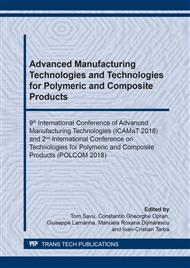[1]
C. Amerio, R. De Ruvo, S. Simonetti, Elementi di tecnologia, © SEI (2011).
Google Scholar
[2]
J. Klett and L. Blessing, Designing connections considering connecting and disconnecting process characteristics and the number of required fasteners, International Conference on Engineering Designed ICED 05, Melbourne (2005).
Google Scholar
[3]
T. Jeandin and C. Mascle, A new model to select fasteners in design for disassembly, Procedia CIRP 40, 425 – 430 (2016).
DOI: 10.1016/j.procir.2016.01.084
Google Scholar
[4]
F. Cosenza, L. Haylock, R. Pinheiro, E. Frias, Captive panel fastener assembly, patent US008506224B2 (2012).
Google Scholar
[5]
B. Bentrim and M. Maloney, Quick acting panel fastener, patent US20110020092A1 (2011).
Google Scholar
[6]
M. Melvin, Quick-acting bolt and nut type fastener having contractible bolt-gripping sleeve, patent US3145611A (1964).
Google Scholar
[7]
J. Chauvin, D. Attali, D. Attia, Method of providing proper vertebral spacing, patent US6371989B1 (2002).
Google Scholar
[8]
G. Stull, SR. Robert T. Auer, Lightweight child-resistant closure, patent US8205761B2 (2009).
Google Scholar
[9]
C. W. Nicolay, & M. J. Vaders, Cranial Suture Complexity in White-Tailed Deer (Odocoileus virginianus). Journal of Morphology 267, 841–849 (2006).
DOI: 10.1002/jmor.10445
Google Scholar
[10]
S. Krauss, Monsonego-Oran, E. Zelzer, E. Fratzl, P. & Shahar, R., Mechanical Function of a Complex Three-Dimensional Suture Joining the Bony Elements in the Shell of the Red-Eared Slider Turtle. Advanced Materials, 21, 407-412 (2009).
DOI: 10.1002/adma.200801256
Google Scholar
[11]
H. Izumi, M. Suzukia, S. Aoyagia, T. Kanzakib, Realistic imitation of mosquito's proboscis: Electrochemically etched sharp and jagged needles and their cooperative inserting motion, Sensors and Actuators A. 165, 115–123 (2011).
DOI: 10.1016/j.sna.2010.02.010
Google Scholar
[12]
X.Q. Kong and C.W. Wu, Measurement and Prediction of Insertion Force for the Mosquito Fascicle Penetrating into Human Skin, Journal of Bionic Engineering, 6 (2), 143-152 (2009) ISSN 1672-6529. https://doi.org/10.1016/S1672-6529(08)60111-0.
DOI: 10.1016/s1672-6529(08)60111-0
Google Scholar
[13]
R.E. Snodgrass, The Anatomical Life of the Mosquito, Smithsonian Miscellaneous Collections, 139 (8), 87 (1959).
Google Scholar
[14]
S.R. Christophers, Aëdes aegypti (L.) the Yellow Fever Mosquito: its Life History, Bionomics and Structure, Cambridge University Press. London, 750 (1960).
DOI: 10.1126/science.133.3463.1473-a
Google Scholar
[15]
K.A. Wright, The anatomy of salivary glands of Anopheles stephensi Liston. Canadian Journal of Zoology, 47, (4), 579-587 (1969) https://doi.org/10.1139/z69-101.
DOI: 10.1139/z69-101
Google Scholar
[16]
B. Jobling, On the fascicle of blood-sucking Diptera In addition a description of the maxillary glands in Phlebotomus papatasi, together with the musculature of the labium and pulsatory organ of both the latter species and also of some other Diptera, Journal of Natural History, 10 (4), 457-461, (1976).
DOI: 10.1080/00222937600770351
Google Scholar
[17]
J. Jones, The Feeding Behavior of Mosquitoes. Scientific American, 238, (6), 138-150 (1978) Retrieved from http://www.jstor.org/stable/24955760.
Google Scholar
[18]
S. Aoyagi, H. Izumi, M. Fukuda, Biodegradable polymer needle with various tip angles and consideration on insertion mechanism of mosquito's proboscis. Sensors and Actuators A. 143, 20–28 (2008).
DOI: 10.1016/j.sna.2007.06.007
Google Scholar
[19]
M. K. Ramasubramanian, O. M. Barham, V. Swaminathan. Mechanics of a mosquito bite with applications to microneedle design. Bioinspiration & Biomimetics, 3, (4) (2008) https://doi.org/10.1088/1748-3182/3/4/046001.
DOI: 10.1088/1748-3182/3/4/046001
Google Scholar
[20]
T.A. Lenau, T. Hesselberg, A.D. Drakidis, P. Silva, S.Gomes, Mosquito inspired medical needles. SPIE Conference on Bioinspiration, Biomimetics, and Bioreplication, 14 (2017).
DOI: 10.1117/12.2261399
Google Scholar
[21]
D. Richter, F.R. Matuschka, S. Andrew, L. Mahadevan, How ticks get under your skin: insertion mechanics of the feeding apparatus of Ixodes ricinus ticks. Proc R Soc B, 280, (2013) http://dx.doi.org/10.1098/rspb.2013.1758.
DOI: 10.1098/rspb.2013.1758
Google Scholar
[22]
D. Norman, La Caffettiera del Masochista, Giunti, Firenze, 238 (1997).
Google Scholar
[23]
W. Lidwell, K. Holden, J. Butler, Principi universali del design, Logos, Modena, 88 (2005).
Google Scholar


